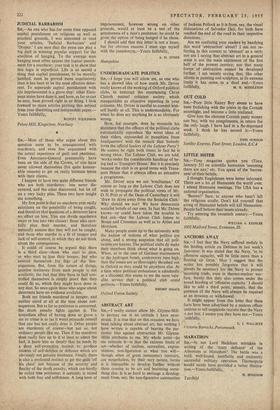ABSTRACT ART
SIR,-1 really cannot allow Mr. Glynne-Mill• to portray me in an attitude I have never struck. It is true that on this occasion we have been talking about abstract art, but nothing I have written is capable of bearing the par. ticular bias against abstraction Mr. Glynne' Mills attributes to me.. My whole point—let me reiterate it—is that the extreme limits of art—whether of realism, surrealism, expres- sionism, non-figuration or what you will— though often of great momentary intensity, are nevertheless, by their very nature, forms it is impossible to develop further without them ceasing to be art and becoming some- thing else. It is as hard to envisage a develop- ment from, say, the non-figurative automatism of Jackson Pollock as it is from, say, the visual dislocations of Salvador Dali, for both have reached the end of the road in their respective directions.
Are we confusing your readers by bandying this word 'abstraction' about? I am not re- ferring in this context to 'abstract' as a verb; nor am I saying that abstract art in a general sense is not the main expression of the first half of the present century; nor that many forms of abstraction cannot be developed further. I am merely saying that, like other idioms in painting and sculpture, at its extreme limits it has come to a dead end.—Yours










































 Previous page
Previous page